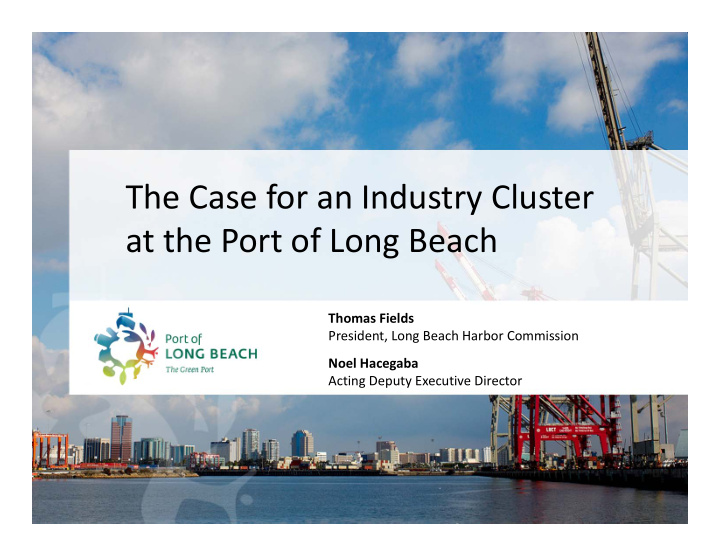



The Case for an Industry Cluster at the Port of Long Beach Thomas Fields President, Long Beach Harbor Commission Noel Hacegaba Acting Deputy Executive Director
Port of Long Beach • 2 nd busiest U.S. port • 6.1 million containers • $20 billion in national, sales, personal income and corporate income taxes
$155 billion a year in trade • Imports include clothing, shoes, toys, furniture and computers • Exports include raw materials
316,000 regional and 1.5 million national jobs 1 in 8 jobs in Long Beach
Vast Distribution Network
Distribution Centers • Southern California has more warehousing space than any other seaport area in the country • 1.7 billion sq ft of distribution and manufacturing centers
Regional Rail Yard Network Off ‐ dock Yards Near ‐ dock On ‐ dock
Industry Cluster Defined An industry cluster is a geographical concentration of interconnected businesses, suppliers and associated institutions in a particular field that share specialized infrastructure, labor markets and services for competitive advantages and gains .
Past Industry Clusters Industrial clusters have been around for a very long time, serving as a catalyst for economic growth. Think Detroit in the heyday of the auto industry or Pittsburg when steelmaking was king.
Current Industry Clusters • Movie Industry (Hollywood) • Silicon Valley (Santa Clara Valley) • Diamond Center (Antwerp, Belgium) • Surgical Instruments (Tuttlingen, Germany) • Nanotechnology (Albany, New York) • Shipbuilding (Finland) Finance (Wall Street, New • York City)
Why Clusters are Important • Clusters help increase higher levels of productivity and innovation. • Tool for economic development, workforce development, community development and education. • Industries in strong clusters register higher employment growth, higher wage growth and increased number of patents. • Often, new industries emerge where there is a strong cluster. • Increases cooperation and linkages between private industry, non ‐ profits and the government sector.
Advantages of Clusters • Concentration of competent people and innovative ideas. • Easier access to specialized suppliers. • Focal point for advanced research and development. • Better access to venture capital and investors. • Lower transaction costs.
Industry Clusters as Economic Development “The enduring competitive advantages in a global economy lies increasingly in local things – knowledge, relationships, motivation – that distant rivals cannot match.” ‐‐ Michael Porter “This role of location has been long overlooked, despite striking evidence that innovation and competitive success in so many fields are geographically concentrated.” ‐‐ Michael Porter
Federal Funding Opportunities • Strong Cities, Strong Communities (SC2) – Six Cities (Detroit; New Orleans; Cleveland; Memphis; Chester, PA; and Fresno) received $1 million grants to develop industrial clusters • Jobs and Innovation Accelerator Challenge • Department of Labor awarded $37 million to 20 regional industrial clusters
The Port, its function and territory … constitute a considerable advantage for the city
Notable Port Clusters • Singapore • Hamburg • Montreal • New York • London
Top Maritime Port Cluster Centers* Port Total Firms Port Total Firms 1. London 406 9. Houston 96 2. Singapore 214 10. Panama City 95 3. New York 166 11. Tokyo 94 4. Piraeus, Greece 161 12. Shanghai 94 5. Hong Kong 150 13. Mumbai, India 74 6. Rotterdam 131 14. Madrid 70 7. Hamburg 109 15. Paris 67 8. Dubai 97 American ports as a whole lag far behind other international ports in creating and attracting industry ‐ related companies. Only two American ports make the list. Notice the Port of Long Beach or Port of Los Angeles are not in the top 15. * The Competitiveness of Global Port Cities. (OECD Regional Development Working Papers)
The Port Economic Engine • $150 billion in trade annually • $4.5 billion capital program • 300,000 regional jobs • 40% of nation’s imports
Economic Engine • Truckers • Shippers • Carriers • Terminal operators • Engineers • Construction firms • Freight forwarders • Law firms….
Maritime Industry Related Businesses • Equipment suppliers • Ship agents • Banking and finance • Legal services • Insurance • Information services • Environmental • Logistics • Construction
Maritime Industry Related Businesses • Real estate rental and leasing • Educational institutions • Security • Engineering • Warehousing • Truck and rail transportation
Goal Develop a framework for a port industry cluster in Long Beach and San Pedro Bay that can be used as a model.
Next Steps • Continue researching successful Maritime Clusters in Europe and Asia in order to identify best practices. • Open discussions with Port of Los Angeles regarding the creation of a San Pedro Bay Maritime Industry Cluster. • Meet with U.S. Representatives Alan Lowenthal and Janice Hahn to explore funding opportunities in Washington, DC. • Identify opportunities for collaboration with local partners.
Prospective Partners • City of Long Beach, County of Los Angeles, State of California, Federal Government • Chambers of Commerce • Labor • Academic institutions
The Case for an Industry Cluster at the Port of Long Beach Thomas Fields President, Long Beach Harbor Commission Noel Hacegaba Acting Deputy Executive Director
Recommend
More recommend